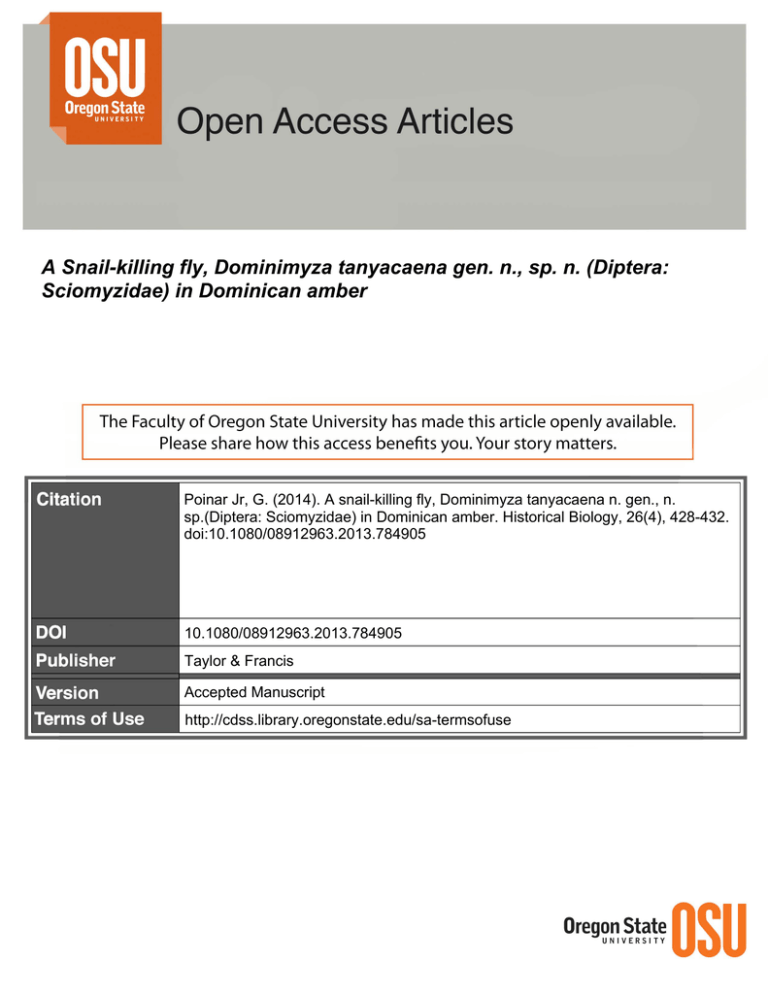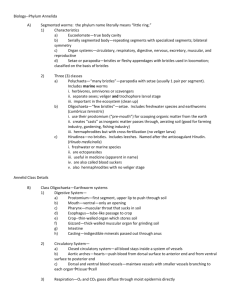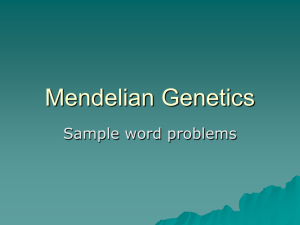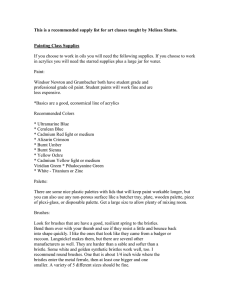A Snail-killing fly, Dominimyza tanyacaena gen. n., sp. n. (Diptera:
advertisement

A Snail-killing fly, Dominimyza tanyacaena gen. n., sp. n. (Diptera: Sciomyzidae) in Dominican amber Poinar Jr, G. (2014). A snail-killing fly, Dominimyza tanyacaena n. gen., n. sp.(Diptera: Sciomyzidae) in Dominican amber. Historical Biology, 26(4), 428-432. doi:10.1080/08912963.2013.784905 10.1080/08912963.2013.784905 Taylor & Francis Accepted Manuscript http://cdss.library.oregonstate.edu/sa-termsofuse A Snail-killing fly, Dominimyza tanyacaena gen. n., sp. n. (Diptera: Sciomyzidae) in Dominican amber. George Poinar, Jr. Department of Zoology, Oregon State University, Corvallis, OR 97331, U.S.A. *Email: poinarg@science.oregonstate.edu 1 Abstract A new genus and species of Snail-killing flies, Dominimyza tanyacaena, n. gen., n. sp. (Diptera: Sciomyzidae) is described from Dominican amber. Diagnostic characters for Dominimyza include a propleuron with a strong bristle, an elongate porrect flagellum with a long, finely pubescent arista, divergent ocellar, post-ocellar and outer vertical bristles, convergent inner vertical bristles, two pairs of frontal-orbital bristles, scutellum with two pairs of marginal scutellar bristles, vallar bristles present, a strong bristle present near the middle of the anterior face of the mid-femora, a clear wing with fuscous areas, A1 fading as it nears the wing margin, R1 extending apicad of the anterior crossvein and the absence of preapical bristles on the fore tibia. This is the first description of a Snail-killing fly in Dominican amber. Keywords: Tertiary amber, Dominican Republic, Sciomyzidae 2 Introduction Snail-killing or Marsh flies (Diptera: Sciomyzidae) are medium-sized flies (from 2-13 mm in length) that often occur in littoral habitats, such as those surrounding saltand freshwater marshes, ponds and lakes. The adults are rather slow flying and rest on vegetation, often with their head directed downwards, along the margins of water sources. The larvae are predators or parasites of snail eggs, slugs, fingernail clams and especially pulmonate snails in both terrestrial and aquatic habitats. Snail-killing fly pupae may be free-floating or occur in litter in the host’s habitat or are formed within the snail shell. Predatory larvae develop on several snails with some larvae begin their development on snail eggs, and then continue feeding on juvenile and adult stages. Certain sciomyzids have been investigated as potential biological control agents of snail vectors of trematodes, including those causing human schistosomiasis (Fisher and Orth 1983; Knutson and Vala 2011; Marinoni and Knutson 2009). The present study describes an adult Snail-killing fly in Dominican amber. Materials and methods The specimen was obtained from “La Toca” mine in the Cordillera Septentrional of the Dominican Republic. Dating of Dominican amber is still controversial with the latest purposed age of 20-15 mya based on foraminifera (Iturralde-Vinent and MacPhee 3 1996) and the earliest as 45-30 mya based on coccoliths (Cêpek in Schlee 1990). In addition, Dominican amber is secondarily deposited in sedimentary rocks, which makes a definite age determination difficult (Poinar and Mastalerz 2000). A range of ages for Dominican amber is possible since the amber is associated with turbiditic sandstones of the Upper Eocene to Lower Miocene Mamey Group (Draper et al. 1994). Dominican amber was produced by the leguminous tree, Hymenaea protera Poinar and a reconstruction of the Dominican amber forest based on amber fossils indicated that the environment was similar to that of a present day tropical moist forest (Poinar and Poinar 1999). . Observations were made with a Nikon SMZ-10 stereoscopic microscope. A Sony DSC-H10 camera was used for photographs. Description Superfamily Sciomyzoidea Family Sciomyzidae Dominimyza Poinar n. gen. Type species: Dominimyza tanyacaena Poinar (Figs. 1-4) Diagnosis: Propleuron with strong bristle; flagellum elongate, porrect, arista long, with fine pubescence; head with ocellar and post-ocellar bristles divergent; inner vertical bristles convergent; outer vertical bristles divergent; two pairs of frontal-orbital bristles; vibrissae absent; sub-vibrissal setae present; 5-6 rows of short frontal setae on both sides; scutellum with two pairs of marginal scutellar bristles; vallar bristles present; strong bristle present near middle of anterior face of middle femora; wing clear except for fuscous apical area, fuscous band positioned just basal to Sc meeting C and faint fuscous 4 spot just basal to R1 meeting C. Costa vein extending to M; A1 fading to wing margin; R1 extending apicad of anterior crossvein, slightly longer than half wing length; halters clear; preapical bristles absent on fore tibia. Etymology: The generic name is based on the site of origin of the fossil plus the Greek myia = fly. Comments: The diverging post-ocellar bristles, two pairs of frontal orbital setae, entire costal wing margin with setae of similar size, the absence of oral vibrissae, the porrect antennae and the strong bristle near the middle of the anterior face of the mid-femora align Dominimyza with the Sciomyzidae. The superfamily Sciomyzoidea also includes the families Coelopidae, Dryomyzidae, Helosciomyzidae, Ropalomeridae and Sepsidae (Marinoni and Knutson 2009). The Helosciomyzidae are mainly restricted to the Southern hemisphere and have hyaline or yellow without maculae (Barnes 1981). Coelopids have unmarked wings and the antennae are appressed to the face (Vockeroth 1987). Dryomyzids have hyaline or uniformly colored wings and if spots are present, they occur over the crossbars (Steyskal 1987A). Ropalomerids have an enlarged hind femur, the eyes extending about the vertex and a unique wing venation (Steyskal 1987B). Sepsids are slender flies with hyaline wings with only an occasional dark spot near the tip and short and decumbent antennae (Steyskal 1987C). Some other families share some characters with Dominimyza. The Lonchaeitdae have a single pair of orbital setae and clear or uniformly fuscous wings, and the flagellum is decumbent when long (McAlpine, 1987). The Lauxaniidae are small flies with short antennae bearing round to short, ovate flagellomeres. The wings are yellow-tinged and if 5 ornamented, are uniformly spotty or clouded. Also, A1 ends abruptly far from the wing margin and the post-ocellar bristles are always convergent (Shewell 1987). Characters that, when taken together, exclude the placement of Dominimyza in any extant or extinct genus in the Sciomyzidae are the elongate flagellum (5 times the length of the pedicel) bearing a long arista (nearly 3 times the length of the flagellum), the fore tibia lacking preapical bristles, the presence of vallar and ocellar bristles, the long R1 vein and A1 vein fading away to the wing margin. Both the Holarctic genus Colobaea Zetterstedt 1837 and the Neotropical genus Parectinocera Becker 1919 have an A1 vein that does not reach the wing margin, although in Dominimyza, A1 becomes faint as it approaches the wing margin. However species of the former genus are under 2.5 mm in length and in the latter genus, vein R1 does not extend apicad of the anterior crossvein. Of the known Neotropical sciomyzids, members of the genus Sepedomerus Steyskal 1973 lack post-ocellar bristles, which separates this genus from Dominimyza (Fisher and Orth 1983). The genus Atrichomelina Cresson 1920 has the fore coxae lacking bristles, which is similar to the fossil, but the propleural bristle is fine and thin and the mesopleuron, propleuron and steropleuron bear long fine hairs, which is not the case in Dominimyza (Fisher and Orth 1983; Steyskal and Knutson 1975; Marinoni and Knutson 2009). In Pherbellia Robineau-Descoidy 1830, a strong anal vein reaches the wing margin, the flagellum is short and the second aristal segment is about as long as wide. In Perilimnia Becker 1919 and Shannonia Malloch 1933, a strong anal vein reaches the wing margin and the flagellum is tapered apically. In the genus Eutrichomelina Steyskal 1975, a strong anal vein reaches the wing margin (Steyskal and Knutson 1975). In the genus Calliscis Steyskal 1975, a strong anal vein reaches the wing 6 margin, there is only 1 pair of fronto-orbital bristles and the wing is hyaline (Steyskal and Knutson 1975). In Antichaeta Haliday 1838, Dictyodes Malloch 1884, Dictya Meigen 1932, Euthycera Latreille 1829, Euthycerina Malloch 1933, Guatemalia Steyskal 1960, Hoplodictya Cresson 1920, Sepedomerus Steyskal 1973, Sepedon Latreille 1804, Sepedonea Steyskal 1973, Tetanocera Duméril 1800, Tetanoceroides Malloch 1933, Teutoniomyia Hennig 1952, Thecomyia Petry 1833, Pseudomelina Malloch 1933 and Protodictya Malloch 1884, all of which have neotropical species, the propleural bristle is absent (Steyskal and Knutson 1975; Freidberg et al. 1991; Fisher and Orth 1983). Dominimyza tanyacaena Poinar, n. sp. (Figs. 1-4) Description: Holotype length, 7.0 mm; wing length, 6.0 mm. Sex unknown. Head: Light brown; large, transverse, compound eyes large, bare; antennae with short scape and pedicel, the latter bearing several setal rows; flagellum elongate, porrect, smooth, bearing long, finely pubescence arista; flagellum/pedicel ratio 3.0; palpus elongate, proboscis moderately short, tip missing; post-ocellar (post-vertical) bristles divergent; inner vertical bristles convergent; outer vertical bristles divergent; with one pair of divergent ocellar bristles and two pairs of frontal-orbital bristles; vibrissae absent; sub-vibrissal setae present; 5-6 rows of short frontal setae on each side of head. Thorax: Light brown, hairy, propleuron with strong bristle above base of fore coxa; each side with single postpronotal setae, one pair of notoplural setae and one pair of intra-alar setae. Notum with three pair of discal setae and scutellum with two pairs of marginal bristles; vallar bristles present. Wing clear except for dark area at apex, dark band positioned just basal of Sc meeting C and faint spot just basal of R1 meeting C. Costa 7 vein extending to M1; A1 fades away at wing margin; R1 extending apicad of anterior crossvein, slightly longer than half wing length; halters clear. Legs relatively short, hairy; fore femur with 2-3 rows of strong bristles along both margins, mid-femur with strong bristle present near middle of anterior face and single row of strong bristles along outer margin; hind femur with row of 5 strong bristles along apical margin. Preapical bristles absent on fore tibia; single strong pre-apical bristle and row of long setae on mid tibia; cluster of apical setae and rows of short setae on hind tibia. Tarsi 5-segmented with paired divergent claws. Abdomen: Dark brown, five-segmented with terminal segment bent inward and obscured. Type: Holotype deposited in the Poinar amber collection (accession # D-7-140) maintained at Oregon State University, Corvallis, Oregon. Type locality: Amber mine (La Toca) in the northern portion of the Dominican Republic. Etymology: The specific epithet is taken from the Greek tany = long and the Greek akaina = spine, in reference to the long arista on the fossil. Discussion Only a single extant species of sciomyzid, Sepedomerus caeruleus (Melander, 1920), has been reported from Hispaniola (Perez-Gelabert 2008). However, members of the genus Sepedomerus lack postocellar bristles as well as a propleural bristle, which distinguish them from Dominimyza (Fisher and Orth 1983; Steyskal and Knutson 1975). Fossil snail-killing flies are uncommon. Previous New World fossils include several specimens from the Eocene Green River beds in Wyoming. The first is Sciomyza revelata Scudder 1878, based on three specimens. Only the wings are well preserved and 8 the short R1 vein (reaching only 0.3 of the total wing length) clearly separates this species from Dominimyza where R1 extends 0.6 of the total wing length. The second Green River fossil, Sciomyza manca Scudder 1878, has a subglobose flagellum, scarcely longer than broad, which separates it from Dominimyza. The small size (averaging 3.2 mm) of the third Green River species, Sciomyza disjecta Scudder 1878, distinguishes it from Dominimyza (Scudder 1878, 1890). Snail-killing flies in the genera Palaeoheteromyza Meunier 1904, Prophaeomyia Hennig 1965, Prosalticella Hennig 1965 and Sepedonites Hennig 1965 have been described form Baltic amber (Hennig 1965). Characters that separate Dominimyza from these is the short, almost round flagellum and strong A1 vein in Palaeoheteromyza, the short flagellum/pedicel ration (2.3) and protibial preapical spine in Prophaeomyia, the short flagellum/pedicel ratio (3.7) and strong A1 vein in Prophaeomyia and the 3segmented arista, strong A1 vein and reduced oribital setae in Sepedonites (Hennig 1965). Adult snail-killing flies commonly occur in wet habitats where the adults can mate and the females are able to locate suitable molluscan hosts. Thus, Dominimyza suggests such a habitat, which could be a ground water source ranging from seepage areas to standing water. The question arises whether Dominimyza could have attacked snails living in phytotelmata such as tank bromeliads. Diving and marsh beetles and a damselfly in Dominican amber suggest the presence of tank bromeliads based on the habits of their descendants. Evidence of standing water comes from the discovery of Dominican amber mosquitoes and a stonefly. Finding pigmy mole crickets indicates a ground water source with sandy banks (Poinar 2010; Poinar and Poinar 1999). In his study of organisms in Neotropical tank bromeliads, Picado (1913) reported finding 9 members of the pulmonate snail genera Drymaeus (Say 1825) (Bulimulidae), Hyalinia Newcomb 1864 (Zonitidae), and Guppya (Pfeiffer, 1839) (Helicarionidae). Apparently none of these genera are known to be hosts to Sciomyzids (Knutson and Vala 2011). However, representatives of the pulmonate snail families Strobilopsidae, Subulinidae (Subulina sp.), Spiraxidae and Ferrussaciidae have been reported from Dominican amber (Poinar and Roth 1991) and extant members of the genus Subulina Beck, which are mainly ground dwelling predators, are known to be hosts of sciomyzids (Knutson and Vala 2011). Acknowledgments The author thanks Monte Wood for calling his attention to Dominimyza and Lloyd Knutson and Robert E. Orth for guidance in the early stages of this study. Grateful appreciation is extended to Roberta Poinar and Art Boucot for comments on an earlier version of the manuscript. 10 References Barnes JK. 1981. Revision of the Helosciomyzidae (Diptera). J Royal Soc New Zealand 11: 45-72. Draper G, Mann P, Lewis JF. 1994. Hispaniola, pp. 129-150. In Donovan S. and Jackson TA. (eds.), Caribbean Geology: An Introduction. The University of the West Indies Publishers' Association, Kingston, Jamaica. Fisher TW, Orth RE. 1983. The Marsh Flies of California (Diptera: Sciomyzidae). Bull California Insect Survey 24: 1-124. Freidberg A, Knutson L, Abercrombie J. 1991. A revision of Sepedonea, a Neotropical genus of snail-killing flies (Diptera: Sciomyzidae). Smithsonian Contrib Zoology 506: 1-56. Hennig W. 1965. Die Acalyptratae des Baltischen Bernsteins. Stuttgarter Beiträge zur Naturkunde 145: 1-215. Iturralde-Vinent MA, MacPhee RDE. 1996. Age and Paleogeographic origin of Dominican amber. Science 273:1850-1852. Knutson LV. 1987. Sciomyzidae. pp. 927-940. In McAlpine JF. (ed.). Manual of Nearctic Diptera Vol. 2. Canada Communication group- Publishing, Ottawa, Canada. 11 Knutson LV, Vala J-C. 2011. Biology of Snail-killing Sciomyzidae flies. Cambridge University Press, Cambidge, 526 pp. Mariononi L, Knutson L. pp. 1017-1025. In Brown BV (ed.), Manual of Central American Diptera. Vol. 2., National Government publication. Ottawa. McAlpine JF. 1987. Lonchaeidae. pp. 791- 797. In McAlpine JF. (ed.). Manual of Nearctic Diptera Vol. 2. Canada Communication group- Publishing, Ottawa, Canada. Perez-Gelabert DE. 2008. Arthropods of Hispaniola (Dominican Republic and Haiti): A checklist and bibliography. Zootaxa 1831. 1-530. Picado C. 1913. Les Broméliacees épiphytes considérées comme milieu biologique. Bull Scientific France et Belgique 47: 215- 360. Poinar GO, Jr., 2010. Palaeoecological perspectives in Dominican amber. Annales Société Entomol France 46: 23-52. Poinar GO, Jr., Roth B. 1991. Terrestrial snails (Gastropoda) in Dominican amber. The Veliger 34: 253-258. Poinar GO, Jr., Poinar R. 1999. The Amber forest. Princeton, NJ: Princeton University Press, 239 pp. Poinar GO, Jr., and Mastalerz M. 2000. Taphonomy of fossilized resins: determining the biostratinomy of amber. Acta Geologica Hispanica 35: 171-182. Schlee D. 1990. Das Bernstein-Kabinett. Stuttg Beitr Naturkunde (C). No. 28, 100 pp. Scudder SH. 1878. The Fossil Insects of the Green River Shales. Bulletin of the United States Geological and Geographical Survey of the Territories 4: 747-776. 12 Scudder SH. 1890. The Tertiary Insects of North America. Rept United States Geol Surv Territories 13: 1-734. Shewell GE. 1987. Lauxaniidae. pp. 951-964. In McAlpine JF. (ed.). Manual of Nearctic Diptera Vol. 2. Canada Communication group- Publishing, Ottawa, Canada. Steyskal, G. C. 1987A. Dryomyzidae pp. 919-922. In McAlpine JF. (ed.). Manual of Nearctic Diptera Vol. 2. Canada Communication group- Publishing, Ottawa, Canada. Steyskal GC. 1987B. Ropalomeridae. pp. 941. In McAlpine JF. (ed.). Manual of Nearctic Diptera Vol. 2. Canada Communication group- Publishing, Ottawa, Canada. Steyskal GC. 1987C. Sepsidae. pp. 945-950. In McAlpine JF. (ed.). Manual of Nearctic Diptera Vol. 2. Canada Communication group- Publishing, Ottawa, Canada. Steyskal GC, Knutson L. 1975. Key to the genera of Sciomyzidae (Diptera) from the Americas south of the United States, with descriptions of two new genera. Proc entomol Soc Washington 77: 274-277. Vockeroth JR. 1987. Coelopidae. pp 919-922. In McAlpine JF. (ed.). Manual of Nearctic Diptera Vol. 2. Canada Communication group- Publishing, Ottawa, Canada. 13 Figures Figure 1. Dorsum of holotype of Dominimyza tanyacaena in Dominican amber. Scale bar = 2.1 mm. Figure 2. Dorsum of head of Dominimyza tanyacaena in Dominican amber. FOB= frontal orbital bristle (only one of the pair labeled); IV = inner vertical bristle (only one of the pair labeled) ; OB = ocellar bristles; OV = outer vertical bristle (only one of the pair labeled); PV = post- ocellar bristles. Scale bar = 380 µm. 14 Figure 3. Left antenna of Dominimyza tanyacaena in Dominican amber. Note porrect flagellum and elongate arista. Scale bar = 360 µm. Figure 4. Right wing of Dominimyza tanyacaena in Dominican amber. Note A1 fading toward wing margin. Scale bar = 1 mm. 15




